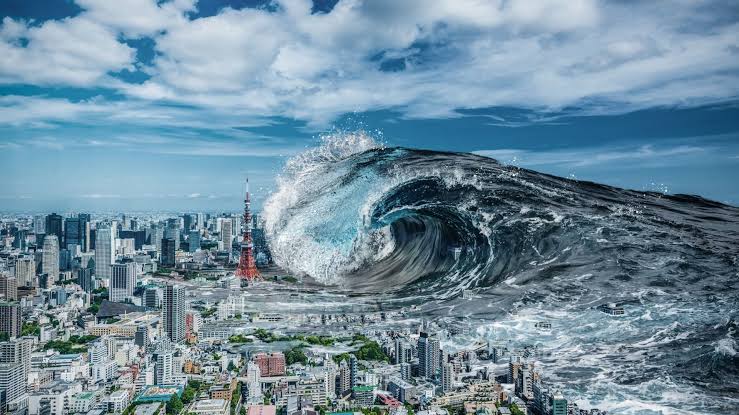🌊 Tsunamis: The Silent Giants of the Ocean
🔹 Introduction
Beneath the calm, blue surface of the sea lies a force so powerful that it can change entire coastlines within minutes. This force is called a tsunami 🌊. Known as the “harbor wave” (from the Japanese word tsu-nami), a tsunami often begins in silence — but when it reaches land, it can cause unimaginable destruction. Understanding tsunamis is crucial, especially for those living near coastal regions.
🔹 What Is a Tsunami?
A tsunami is a series of powerful sea waves caused by a sudden disturbance beneath the ocean, such as:
- 🌍 Underwater Earthquakes
- 🌋 Volcanic Eruptions
- ⛰️ Submarine Landslides
- ☄️ Asteroid or Meteor Impacts (rare)
These waves can travel at jet-like speeds — up to 800 km/h — across vast distances, unnoticed in deep water. But as they approach land, their energy builds up and turns into massive, towering waves that crash into the shore.
🔹 How Do Tsunamis Form? 🌀
- Triggering Event: An earthquake or volcanic eruption suddenly shifts the sea floor.
- Water Displacement: A large volume of seawater is displaced instantly.
- Wave Generation: Waves form and spread rapidly across the ocean.
- Shoaling Effect: As they reach shallow waters, waves slow down and grow in height.
- Impact: Enormous waves strike coastal areas, often with devastating force.
📏 Some tsunamis can reach heights of 10 meters or more — that's taller than a 3-story building!
🔹 Tsunami vs. Normal Ocean Waves
| 🌊 Feature | 🌪 Tsunami | 🌬️ Regular Wave |
|---|---|---|
| Cause | Earthquakes, volcanic activity | Wind on the ocean surface |
| Speed | Up to 800 km/h 🚄 | 10–100 km/h 🚤 |
| Noticeable in Deep Sea? | No 👀 | Yes 🌬️ |
| Warning Time | Often very short ⚠️ | Predictable ⏰ |
🔹 Warning Signs of an Approaching Tsunami 🚨
- A strong earthquake
- The sea suddenly pulling back 🌊⬅️
- A loud roaring sound from the ocean 🐘🌊
- Official alerts via sirens or mobile warnings 📱📢
📢 Golden Rule: If the ocean retreats suddenly after an earthquake — don’t wait, evacuate immediately!
🔹 Real Example: The 2004 Indian Ocean Tsunami 📅
On December 26, 2004, a 9.1-magnitude earthquake occurred under the Indian Ocean near Indonesia. It caused a massive tsunami that:
- Affected 14 countries
- Killed over 230,000 people
- Destroyed entire towns and villages
- Reached as far as the east coast of Africa
This tragedy led to the development of advanced warning systems and greater global awareness about tsunami risks.
🔹 Tsunami Safety Tips for Students & Communities 🛟
- Follow evacuation signs and drills
- Move to higher ground if you feel an earthquake
- Never go to the beach to watch a tsunami 🌊👀
- Learn from school safety programs
- Keep a basic emergency kit ready
🔹 Environmental Impact of Tsunamis 🌱
Tsunamis don’t just affect people — they can severely damage:
- 🌾 Farmland and crops
- 🏞️ Forests and coastal vegetation
- 🐠 Marine ecosystems
- 🏠 Infrastructure and homes
Recovery from a tsunami often takes years, both environmentally and economically.
🔹 Conclusion
Tsunamis are the silent giants of the ocean — they may not roar until the last minute, but their impact is loud and lasting. Through education, preparedness, and technology, we can reduce the loss of lives and damage. 🧠📚
Let us be aware, be alert, and respect the mighty ocean. After all, knowledge is the first step to safety. 💡✅
